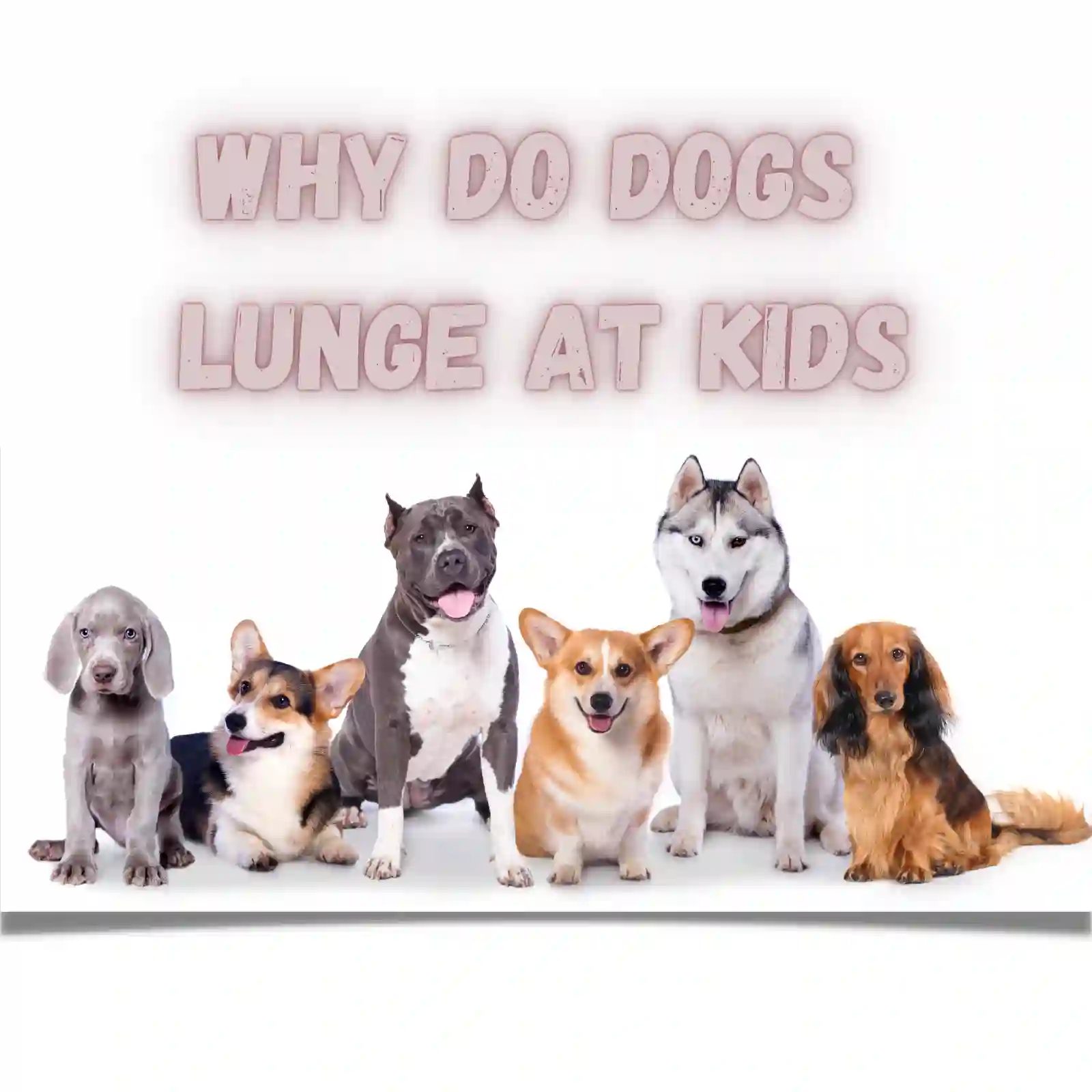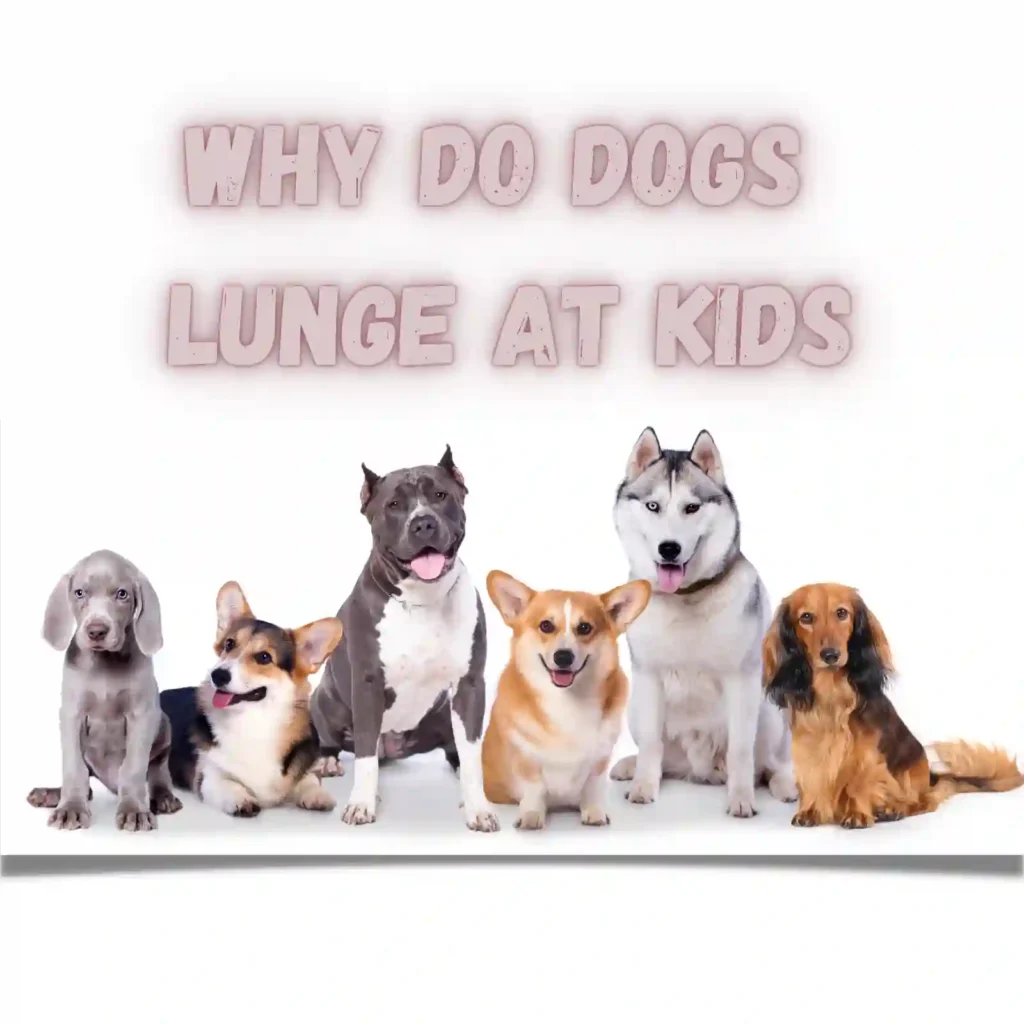
Why Do Dogs Lunge At Kids

Why Do Dogs Lunge At Kids
Aggressive behavior is not inherent to any particular breed, and any dog, regardless of breed, has the potential to become aggressive if not properly trained, socialized, and managed.
It’s important to remember that every dog is an individual, and their behavior is influenced by a range of factors, including their genetics, temperament, and past experiences. Furthermore, aggressive behavior towards children is always unacceptable and requires prompt intervention.
Rather than focusing on specific breeds, it’s important for dog owners and parents to educate themselves on responsible dog ownership, including proper training, socialization, and supervision around children. This will help to prevent aggressive behavior and promote safe and happy interactions between dogs and children.
Today I will try to break down the reasons of why I think dogs lunge at kids.
Reasons Why Dogs Lunge At Kids
Below I’m going to cover the top reasons of why dogs lunge at kids. Note that most of them are very dependent on the dog and not the breed itself. There’s a lot of factors that go into this so I’m only talking here out of personal experience owning a bunch of dogs and talking with other dog owners in my community.
Fear
Dogs can become scared of children if they haven’t been exposed to them before or have had a negative experience. For example, if a child pulls a dog’s tail or ear, the dog may become fearful and try to defend itself. Breeds that are more prone to fear aggression include Chihuahuas and Dachshunds.
Protectiveness
Dogs may become protective of their owners or their territory and view children as a threat. Particularly for breeds that are known for their protective nature, such as German Shepherds and Rottweilers.
Playfulness
Dogs can become overexcited when playing and may accidentally nip at a child. The ones more playful and prone to this behavior include Labrador Retrievers and Golden Retrievers.
Prey Drive
Some dogs have a strong instinct to chase and hunt small animals, which can include children running and playing. The high prey drive include Greyhounds and Jack Russell Terriers.
Lack of Socialization
Dogs that haven’t been socialized properly may not know how to interact with children and may react inappropriately. There are more independent and not as social, such as Basenjis and Afghan Hounds.
Pain or Illness
Dogs that are in pain or are feeling unwell may lash out at anyone who comes near them, including children. In this case pretty much every dog breed I know could be falling for it since illness hits every dog.
Territoriality
Dogs can become territorial over their food or toys, and may see children as a threat if they approach. Some breeds that are known for being possessive, such as Bull Terriers and Shar Peis.
Dominance
Dogs that have a strong sense of dominance may see children as subordinate and try to assert their dominance. In this case the dominant personality breeds, such as Akitas and Doberman Pinschers.
Previous Trauma
Dogs that have been abused or mistreated in the past may be more likely to lash out at children. Again this can apply on any dog breed depending on what history it has.
Lack of Training
Dogs that haven’t been trained properly may not know how to behave around children and may react inappropriately.
It’s important to note that not all dogs of a certain breed will exhibit these behaviors, and any dog can become aggressive if it’s not treated properly. Many of these behaviors can be prevented or corrected through proper training and socialization.
Things To Do To Prevent Dogs From Lunging At Kids
If your dog is lunging at kids, it’s important to take action to prevent any potential harm. Here are some things you can do to help stop your dog from lunging at kids:
Identify the cause
Understanding why your dog is lunging at kids is important for developing a solution. If your dog is fearful or anxious around kids, you may need to work on socialization and exposure to help them become more comfortable. If your dog is possessive of toys or food, you may need to work on training them to share and be less possessive.
Work on obedience training
Teaching your dog basic obedience commands such as “sit,” “stay,” and “come” can help you manage their behavior around kids. Use positive reinforcement techniques such as treats and praise to reinforce good behavior.
Use a leash and muzzle
If your dog is prone to lunging at kids, use a leash and muzzle to prevent any potential harm. This can help you control your dog’s movements and prevent them from harming anyone.
Manage your dog’s environment
If your dog is prone to lunging at kids, avoid situations where they may come into contact with kids. This may mean keeping your dog in a separate room when kids are over or keeping them on a leash when out in public.
Seek professional help
If your dog’s lunging behavior is persistent or you’re unsure how to manage it, consider seeking help from a professional dog trainer or behaviorist. They can help you identify the cause of the behavior and develop a training plan to address it.
Practice desensitization and counter-conditioning
Desensitization involves gradually exposing your dog to the trigger (in this case, kids) in a controlled environment. Counter-conditioning involves changing your dog’s emotional response to the trigger. For example, if your dog is fearful of kids, you can pair the presence of kids with something positive, like treats or playtime.
Teach your dog a “place” command
Teaching your dog to go to a designated spot or “place” can help them feel more secure and less likely to lunge at kids. Use positive reinforcement techniques to teach your dog to go to their place and stay there until released.
Supervise interactions with kids
Never leave your dog and kids unsupervised, even if you trust your dog. Always be present to monitor interactions and intervene if necessary.
Be consistent with training
Consistency is key when it comes to training your dog. Make sure everyone in your household is on the same page and using the same commands and techniques.
Avoid punishment-based training
Punishing your dog for lunging at kids can actually make the behavior worse. Instead, focus on positive reinforcement techniques to encourage good behavior.
Remember that lunging behavior towards kids is always unacceptable and requires prompt intervention. By taking the appropriate steps, you can help prevent any potential harm and promote safe and happy interactions between your dog and kids.
Conclusion
Hopefully we covered the basics and gave you an idea of why your dog may be lunging in your kids. In my personal experience having owned a lot of dogs in the past it’s just a matter of being patient and following a steady routine with them and they will eventually settle in. Best of luck and remember to be armed with patience dogs take time to adopt and break habits like lunging into kids.
Related
- Simple tips on feline hygiene for life with the new baby and family life
- Pregnancy and Cats some tricks and myths busted!
References
You may also like

What Country Has The Most Homeless Dogs

Why Do Dogs Let Cats Bully Them

What Is The Russian Version Of German Shepherd
Archives
- December 2025
- November 2025
- October 2025
- September 2025
- August 2025
- October 2023
- September 2023
- August 2023
- July 2023
- June 2023
- May 2023
- April 2023
- March 2023
- February 2023
- January 2023
- December 2022
- November 2022
- October 2022
- September 2022
- August 2022
- June 2022
- May 2022
- April 2022
- March 2022
- January 2022
- December 2021
- November 2021
- October 2021
- August 2021
- November 2020
- July 2020
- May 2020
- April 2020
- March 2020
- August 2018
- July 2018
- June 2018
- April 2018
- March 2018
Calendar
| M | T | W | T | F | S | S |
|---|---|---|---|---|---|---|
| 1 | 2 | 3 | 4 | |||
| 5 | 6 | 7 | 8 | 9 | 10 | 11 |
| 12 | 13 | 14 | 15 | 16 | 17 | 18 |
| 19 | 20 | 21 | 22 | 23 | 24 | 25 |
| 26 | 27 | 28 | 29 | 30 | 31 | |
Categories
- Aftercare Procedures
- Age Groups
- AI/ML
- Alternative Medicine
- Animal Health
- Animal Husbandry
- Animals
- Anti-Aging
- Architectural Design
- Art And Technology
- Auditory Science
- Augmented Reality
- Automation
- Babies
- Baby
- Beauty & Skincare
- Biohacking
- Biomechanics
- Book Reviews
- Breastfeeding
- Budgeting
- Budgeting Strategies
- Business
- Cardiovascular Health
- Career Advice
- Career Development
- Career Growth
- Cats
- Chess
- Chronobeauty
- Circular Economy
- Cleaning Tips
- Cloud Computing
- Cognitive Health
- Cognitive Performance
- Cognitive Science
- Community
- Community Building
- Community Engagement
- Community Living
- Computer Vision
- Consumer Guides
- Consumer Trends
- Container Gardening
- Content Analysis
- Content Non-Technical
- Content Strategy
- Cosmetic Chemistry
- Cultural Events
- Cycling
- Data Analysis
- Data Engineering
- Data Science
- Database
- Design Psychology
- Design Trends
- Developer Productivity
- Diet
- Diet
- Digital Identity
- Digital Media
- Digital Wellbeing
- DIY Projects
- Dogs
- Engineering Culture
- Entertainment News
- Environmental Impact
- Environmental Science
- Equity Compensation
- Ethical AI
- Exercise
- Exercise Science
- Exercise Technique
- Exotic Pets
- Fall Gardening
- Family
- Family Health
- Family Life
- Fashion Business
- Fashion Industry
- Fashion News
- Fashion Tech
- Financial Analysis
- Financial Optimization
- Financial Planning
- Flooring Maintenance
- Food
- Food Psychology
- Food Safety
- Food Tech
- Functional Fitness
- Functional Training
- Future Of Work
- Garden Care
- Garden Maintenance
- Gardening Tips
- Gig Economy
- Greece
- Greek
- Greek Food
- Green Technology
- Gymnastics
- Hardware Engineering
- Health
- Health And Wellness
- Health Informatics
- Health Science
- Health Tech
- Healthcare Management
- Healthy Eating
- Healthy Recipes
- Holistic Health
- Holistic Wellness
- Home & Living
- Home Decor
- Home Financing
- Home Health
- Home Improvement
- Home Organization
- Home Styling
- Horticulture
- Identity Management
- Industrial Design
- Industry Analysis
- Infant Nutrition
- Infrastructure Management
- Ingredient Deep Dive
- Integrative Health
- Integrative Medicine
- Interior Design
- Internet of Things
- Internet of Things (IoT)
- Invalid Request
- Investment Strategies
- Investment Strategy
- IoT
- Kids
- Leadership Development
- Learning Strategies
- Lifestyle
- Lifestyle Brands
- Lifestyle News
- Lifestyle Optimization
- Literary Criticism
- Literature
- Logistics Management
- Material Science
- Materials Science
- Meal Planning
- Media Analysis
- Meditation
- Mental Health
- Mental Performance
- Mental Wellness
- Miami
- Miami Food
- Mind And Body
- Minimalism
- Mobile Development
- Neuroscience
- No Applicable Categories
- Nutrition
- Nutrition News
- Open Source
- Operating Systems
- Operational Resilience
- Opinion
- Organization Tips
- Outdoor Living
- Over 40
- Over 50
- Over 60
- Parenting
- Parenting
- Parenting Strategies
- Performance
- Performance Optimization
- Personal Development
- Personal Finance
- Personal Growth
- Personal Productivity
- Pet Care
- Pet Safety
- Philosophy
- Politics
- Productivity
- Productivity Engineering
- Protein
- Psychology
- Psychology of Space
- Reading Culture
- Real Estate Investment
- Recipes
- Regulatory Compliance
- Remote Work
- Renovation Planning
- Resource Management
- Respiratory Health
- Responsible Pet Ownership
- Retail Strategy
- Robotics
- Science
- Seafood
- Seasonal Gardening
- Security
- Sedentary Health
- Self-Care
- Skincare Science
- Skincare Trends
- Sleep
- Sleep Health
- Smoothies
- Social Impact
- Soft Skills
- Soil Health
- Spatial Computing
- Spatial Design
- Stress Management
- Supplements
- Sustainability
- Sustainability Science
- Sustainable Engineering
- Sustainable Fashion
- Systems Engineering
- Tax Optimization
- Tax Strategy
- Tech Investment
- Travel
- Travel News
- Travel Safety
- Travel Tips
- Trend Analysis
- Uncategorized
- Urban Planning
- User Experience
- Veggie
- Vietnam
- Virtual Events
- Volunteering
- Wealth Management
- Wearable Technology
- Wellness
- Wellness Technology
- Winter Gardening
- Work-Life Balance
- Workplace Culture
- World
- Writing
- Writing Skills
- Year In Review
- Yoga News
- Zero Waste







Leave a Reply